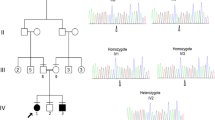Abstract.
Primary distal renal tubular acidosis (dRTA) type I is a hereditary renal tubular disorder, which is characterized by impaired renal acid secretion resulting in metabolic acidosis. Clinical symptoms are nephrocalcinosis, nephrolithiasis, osteomalacia, and growth retardation. Biochemical alterations consist of hyperchloremic metabolic acidosis, hypokalemia with muscle weakness, hypercalciuria, and inappropriately raised urinary pH. Autosomal dominant and rare forms of recessive dRTA are known to be caused by mutations in the gene for the anion exchanger AE1. In order to identify a gene responsible for recessive dRTA, we performed a total genome scan with 303 polymorphic microsatellite markers in six consanguineous families with recessive dRTA from Turkey. In four of these there was an association with sensorineural deafness. The total genome scan yielded regions of homozygosity by descent in all six families on chromosomes 1, 2, and 10 as positional candidate region. In one of these regions the gene ATP6B1 for the ß1 subunit of the vacuolar H+-ATPase is localized, which has recently been identified as causative for recessive dRTA with sensorineural deafness. Therefore, we conducted mutational analysis in 15 families and identified potential loss-of-function mutations in ATP6B1 in 8. We thus confirmed that defects in this gene are responsible for recessive dRTA with sensorineural deafness.

Similar content being viewed by others
References
Bruce LJ, Cope DL, Jones GK, Schofield AE, Burley M, Povey S, Unwin RJ, Wrong O, Tanner MJ (1997) Familial distal renal tubular acidosis is associated with mutations in the red cell anion exchanger (Band 3, AE1) gene. J Clin Invest 100:1693–1707
Karet FE, Gainza FJ, Gyory AZ, Unwin RJ, Wrong O, Tanner MJ, Nayir A, Alpay H, Santos F, Hulton SA, Bakkaloglu A, Ozen S, Cunningham MJ, Pietro A di, Walker WG, Lifton RP (1998) Mutations in the chloride-bicarbonate exchanger gene AE1 cause autosomal dominant but not autosomal recessive distal renal tubular acidosis. Proc Natl Acad Sci U S A 95:6337–6342
Tanphaichitr VS, Sumboonnanonda A, Ideguchi H, Shayakul C, Brugnara C, Takao M, Veerakul G, Alper SL (1998) Novel AE1 mutations in recessive distal renal tubular acidosis. Loss-of-function is rescued by glycophorin A. J Clin Invest 102:2173–2179
Batlle DC, Sehy JT, Roseman MK, Arruda JA, Kurtzman NA (1981) Clinical and pathophysiologic spectrum of acquired distal renal tubular acidosis. Kidney Int 20:389–396
Brown MT, Cunningham MJ, Ingelfinger JR, Becker AN (1993) Progressive sensorineural hearing loss in association with distal renal tubular acidosis. Arch Otolaryngol Head Neck Surg 119:458–460
Karet FE, Finberg KE, Nelson RD, Nayir A, Mocan H, Sanjad SA, Rodriguez-Soriano J, Santos F, Cremers CW, Di Pietro A, Hoffbrand BI, Winiarski J, Bakkaloglu A, Ozen S, Dusunsel R, Goodyer P, Hulton SA, Wu DK, Skvorak AB, Morton CC, Cunningham MJ, Jha V, Liton RP (1999) Mutations in the gene encoding B1 subunit of H+-ATPase cause renal tubular acidosis with sensorineural deafness. Nat Genet 21:84–90
Weber JL, Broman KW (2001) Genotyping for human whole-genome scans: past, present, and future. Adv Genet 42:77–96
Lander ES, Botstein D (1987) Homozygosity mapping: a way to map human recessive traits with the DNA of inbred children. Science 236:1567–1570
Dib C, Faure S, Fizames C, Samson D, Drouot N, Vignal A, Millasseau P, Marc S, Hazan J, Seboun E, Lathrop M, Gyapay G, Morissette J, Weissenbach J (1996) A comprehensive genetic map of the human genome based on 5,264 microsatellites. Nature 380:152–154
Hildebrandt F, Strahm B, Nothwang HG, Gretz N, Schnieders B, Singh-Sawhney I, Kutt R, Vollmer M, Brandis M (1993) Mapping of a gene for familial juvenile nephronophthisis: refining the map and defining flanking markers on chromosome 2. APN Study Group. Am J Hum Genet 53:1256–1261
Orita M, Suzuki YH, Sakiya T, Hayaski K (1989) Rapid and sensitive detection of points mutations and DNA polymorphisms using the polymerase chain reaction. Genomics 5:874–879
Hildebrandt F, Otto E, Rensing C, Nothwang HG, Vollmer M, Adolphs J, Hanusch H, Brandis M (1997) A novel gene encoding an SH3 domain protein is mutated in nephronophthisis type 1. Nat Genet 17:149–153
Venter JC, Adams MD, Myers EW, Li PW, Mural RJ, Sutton GG, Smith HO, Yandell M, Evans CA, Holt RA, Gocayne JD, Amanatides P, Ballew RM, Huson DH, Wortman JR, Zhang Q, Kodira CD, Zheng XH, Chen L, Skupski M et al. (2001) The sequence of the human genome. Science 291:1304–1351
Smith AN, Skaug J, Choate KA, Nayir A, Bakkaloglu A, Ozen S, Hulton SA, Sanjad SA, Al-Sabban EA, Lifton RP, Scherer SW, Karet FE (2000) Mutations in ATP6N1B, encoding a new kidney vacuolar proton pump 116-kD subunit, cause recessive distal renal tubular acidosis with preserved hearing. Nat Genet 26:71–75
Karet FE (2000) Inherited renal tubular acidosis. Adv Nephrol Necker Hosp 30:147–162
Acknowledgements.
We wish to thank Anita Imm for excellent technical assistance as well as R. Betz, T. Kratzin, M. Kremer, and T. Kunzen for help with total genome haplotype analysis. C.R. was supported by a grant from the Wissenschaftliche Gesellschaft Freiburg. F.H. is a Heisenberg Scholar of the German Research Foundation (Hi 381/7–1).
Author information
Authors and Affiliations
Corresponding author
Rights and permissions
About this article
Cite this article
Ruf, R., Rensing, C., Topaloglu, R. et al. Confirmation of the ATP6B1 gene as responsible for distal renal tubular acidosis. Pediatr Nephrol 18, 105–109 (2003). https://doi.org/10.1007/s00467-002-1018-8
Received:
Revised:
Accepted:
Published:
Issue Date:
DOI: https://doi.org/10.1007/s00467-002-1018-8




